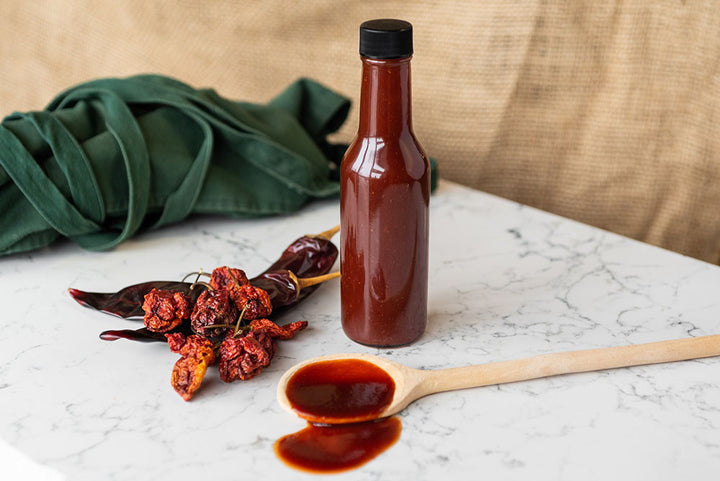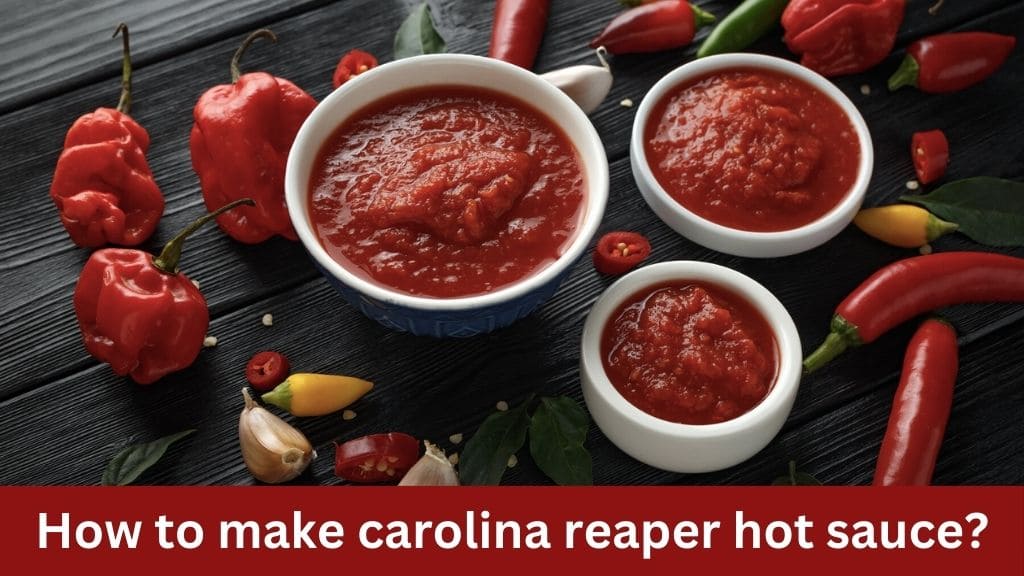In this comprehensive guide, we’ll delve into the world of extreme heat and flavor with a step-by-step tutorial on crafting your own Carolina Reaper hot sauce. From understanding the fiery Carolina Reaper pepper to mastering the art of balancing flavors, this recipe promises to elevate your culinary adventures to new heights. So, grab your gloves and prepare for a journey into the realm of intense heat and unparalleled taste.

Carolina Reaper hot sauce is not for the faint of heart. With its Scoville rating surpassing 2 million SHU, this sauce packs a fiery punch that will test even the most seasoned spice enthusiasts. But beyond its intense heat, Carolina Reaper hot sauce offers layers of flavor that make it a favorite among chili aficionados. From its fruity undertones to its lingering heat, each bottle of homemade Carolina Reaper hot sauce is a testament to the art of spice mastery.
Ingredients You’ll Need

To embark on your Carolina Reaper hot sauce journey, gather the following ingredients:
- Carolina Reaper Peppers: 7 peppers
- Water: ¼ cup
- Lemon: ½ (for its juice)
- Vinegar: 1 tablespoon
- Salt: ½ teaspoon
- Sugar: ½ teaspoon
Step-by-Step Recipe

1. Prepare the Peppers
Before you begin grilling the Carolina Reaper peppers, it’s essential to prepare them properly:
- Destemming: Start by removing the stems from each Carolina Reaper pepper. This can be done by gently twisting or cutting off the stems with a knife.
- Halving the Peppers: Once the stems are removed, carefully cut each pepper in half lengthwise. This will help to expose the seeds and membranes inside, which contain the majority of the pepper’s heat.
- Arranging on Baking Tray: Place the halved peppers on a baking tray with the skin side facing up. This will allow the peppers to grill evenly and develop a charred exterior.
2. Grill the Peppers
Grilling the Carolina Reaper peppers adds depth of flavor and a smoky char that enhances the overall taste of the hot sauce. Follow these steps for optimal grilling:
- Preheat the Grill: Ensure your grill is preheated to medium-high heat before placing the peppers on the grates. This will help to sear the peppers quickly and evenly.
- Grilling Time: Grill the peppers for approximately 7 minutes, or until they start to blister and blacken. Keep a close eye on the peppers to prevent them from burning.
- Turning the Peppers: If necessary, carefully turn the peppers halfway through the grilling process to ensure even cooking. This will help to achieve a uniform char on all sides of the peppers.
- Monitoring Heat: Adjust the heat of your grill as needed to maintain a consistent temperature throughout the grilling process. This will help to prevent the peppers from cooking too quickly or becoming overly charred.
3. Blend the Ingredients
Once the peppers are grilled to perfection, it’s time to blend them with the remaining ingredients to create the hot sauce:
- Transfer to Blender: Carefully transfer the grilled peppers to a blender or food processor. Be sure to include any juices or oils that may have accumulated on the baking tray during grilling, as these will add flavor to the sauce.
- Adding Additional Ingredients: In addition to the grilled peppers, add water, lemon juice, vinegar, salt, and sugar to the blender. These ingredients will help to balance the intense heat of the Carolina Reaper peppers and enhance the overall flavor of the sauce.
4. Blend Until Smooth
With all the ingredients in the blender, it’s time to blend until the mixture reaches a smooth and uniform consistency:
- Start Slowly: Begin blending on a low speed to break down the peppers and other ingredients gradually. This will help to prevent splattering and ensure that everything is evenly mixed.
- Increase Speed: Once the ingredients are partially blended, increase the speed of the blender to fully incorporate everything into a smooth sauce. Blend for approximately 1-2 minutes, or until no large chunks remain.
- Check Consistency: Pause occasionally to check the consistency of the sauce. If necessary, add additional water or lemon juice to thin it out, or blend for longer to achieve a smoother texture.
5. Store and Enjoy
With your Carolina Reaper hot sauce blended to perfection, it’s time to store it and savor the fruits of your labor:
- Transfer to Container: Carefully transfer the hot sauce to an airtight container or glass bottle. Use a spatula or spoon to scrape any remaining sauce from the blender, ensuring that none goes to waste.
- Refrigerate: Seal the container tightly and refrigerate the hot sauce until ready to use. The cold temperature will help to preserve the freshness and flavor of the sauce, allowing you to enjoy it for weeks to come.
- Handle with Caution: Remember to exercise caution when handling and consuming Carolina Reaper hot sauce, as it is extremely spicy. Start with small amounts and gradually increase according to your tolerance level, and always wash your hands thoroughly after handling the peppers.
Safety Tips

1. Wear Protective Gear
- Gloves: Always wear gloves when handling Carolina Reaper peppers, as well as any other hot peppers. The oils from the peppers can cause irritation and burning sensations on the skin, which can be extremely uncomfortable. Opt for disposable gloves made of latex or nitrile to protect your hands from direct contact with the peppers.
- Eye Protection: In addition to gloves, consider wearing protective eyewear, such as safety glasses or goggles, to shield your eyes from any accidental contact with pepper oils. Even a small amount of pepper residue on your hands can cause intense burning if it comes into contact with your eyes, so it’s essential to take precautions.
2. Ensure Proper Ventilation
- Open Windows and Doors: Carolina Reaper peppers emit potent fumes when cooked or blended, which can irritate the respiratory system and cause discomfort. To minimize exposure to these fumes, ensure that your kitchen is well-ventilated by opening windows and doors. Using a kitchen fan or extractor hood can also help to remove airborne particles and improve air circulation.
- Cook Outdoors (Optional): If possible, consider grilling the peppers outdoors on a barbecue or grill. This not only allows for better ventilation but also reduces the risk of fumes lingering in indoor spaces. Plus, cooking outdoors can add a delightful smoky flavor to the peppers, enhancing the overall taste of the hot sauce.
3. Handle with Care
- Avoid Touching Face: While wearing gloves, be mindful of not touching your face, especially your eyes, nose, and mouth, as this can transfer pepper oils and cause irritation. If you accidentally touch your face, wash your hands thoroughly with soap and water immediately to remove any traces of pepper residue.
- Minimize Skin Contact: When destemming and halving the Carolina Reaper peppers, try to minimize direct skin contact as much as possible. Use a knife or kitchen utensil to handle the peppers, and avoid touching the seeds and membranes with your bare hands.
4. Start Small
-
- Gradual Introduction: Carolina Reaper hot sauce is exceptionally spicy, so it’s essential to start with small amounts and gradually increase according to your tolerance level. A few drops of hot sauce can pack a powerful punch, so exercise caution when adding it to dishes or recipes.
- Taste Test: Before incorporating Carolina Reaper hot sauce into a recipe, consider doing a taste test to gauge its heat level. Dip the tip of a toothpick or small spoon into the sauce and taste a tiny amount. If it’s too spicy for your liking, dilute it with additional ingredients such as water or citrus juice to mellow out the heat.
Flavor Variations

1. Additional Ingredients
- Roasted Garlic: For added depth of flavor, consider incorporating roasted garlic into your hot sauce recipe. Roasting garlic brings out its natural sweetness and mellows out its sharpness, resulting in a rich and savory addition to the sauce.
- Onion: Finely chopped or sautéed onion can add complexity and depth to the hot sauce, complementing the intense heat of the Carolina Reaper peppers. Consider caramelizing the onions for a sweeter flavor profile or using them raw for a sharper bite.
- Herbs and Spices: Experiment with adding fresh or dried herbs and spices to the hot sauce to enhance its flavor profile. Consider options such as cilantro, cumin, coriander, or oregano for a Mexican-inspired twist, or try adding smoked paprika for a hint of smokiness.
2. Vinegar Varieties
- Apple Cider Vinegar: While the basic recipe calls for vinegar, you can experiment with different types of vinegar to achieve varying flavor profiles. Apple cider vinegar adds a fruity sweetness and tanginess to the hot sauce, balancing out the heat of the peppers.
- Balsamic Vinegar: For a more complex and nuanced flavor, consider using balsamic vinegar in place of traditional white vinegar. Balsamic vinegar adds a rich and slightly sweet flavor to the hot sauce, complementing the earthy notes of the Carolina Reaper peppers.
- Rice Vinegar: Rice vinegar offers a mild and slightly sweet flavor profile, making it an excellent choice for those looking to tone down the heat of the hot sauce without sacrificing flavor. Its subtle acidity helps to balance out the intense spiciness of the peppers.
3. Additional Heat Sources
- Ghost Peppers: If you’re looking to up the ante on heat, consider incorporating ghost peppers into your hot sauce recipe. Ghost peppers are known for their intense heat and fruity flavor, making them a perfect complement to the Carolina Reaper peppers.
- Scorpion Peppers: Similarly, scorpion peppers pack a powerful punch of heat and flavor, making them an ideal addition to Carolina Reaper hot sauce. Their floral and fruity notes add complexity to the sauce, while their intense heat level enhances the overall spiciness.
4. Sweet and Tangy Additions
- Fruit: Adding fruit to your hot sauce can impart natural sweetness and acidity, balancing out the heat of the peppers. Consider options such as mango, pineapple, or peach for a tropical twist, or opt for berries such as raspberries or strawberries for a tangy kick.
- Citrus Juice: Freshly squeezed lemon or lime juice can add a bright and zesty flavor to the hot sauce, cutting through the richness of the peppers. The acidity of citrus juice helps to balance out the heat and adds a refreshing twist to the sauce.
5. Experimentation is Key
Don’t be afraid to get creative and experiment with different flavor combinations to find your perfect Carolina Reaper hot sauce recipe. Whether you’re adding ingredients like roasted garlic and onions or experimenting with different vinegar varieties and heat sources, the key is to have fun and let your taste buds be your guide. With a bit of experimentation and creativity, you can create a hot sauce that is truly unique and tailored to your personal preferences.
FAQ

1. How long does Carolina Reaper hot sauce last?
Carolina Reaper hot sauce can typically be stored in the refrigerator for several months. The high acidity from the vinegar helps to preserve the sauce, making it safe to consume for an extended period. However, for optimal flavor and freshness, it’s best to consume the hot sauce within a reasonable timeframe.
2. How spicy is Carolina Reaper hot sauce?
Carolina Reaper hot sauce is exceptionally spicy, thanks to the intense heat of the peppers. The Carolina Reaper pepper holds the title of the world’s hottest pepper, boasting a Scoville rating that surpasses 2 million SHU (Scoville Heat Units). As a result, even a small amount of Carolina Reaper hot sauce can pack a powerful punch, so it’s essential to use caution when adding it to dishes.
3. Where can I find Carolina Reaper peppers?
Carolina Reaper peppers can be found at specialty grocery stores or purchased online from reputable suppliers. Additionally, some farmers’ markets or specialty food shops may carry fresh or dried Carolina Reaper peppers. If you’re feeling adventurous, you can also try growing your own Carolina Reaper peppers at home, but be prepared for the intense heat they bring to the table.
4. Can I use other peppers for this recipe?
Absolutely! While Carolina Reaper peppers are the star of the show in this hot sauce recipe, you can experiment with other types of peppers to achieve different flavor profiles and heat levels. Ghost peppers, scorpion peppers, habaneros, or even milder varieties like jalapenos or serranos can all be used to customize the hot sauce to your taste preferences. Feel free to mix and match peppers to create a hot sauce that suits your desired level of spiciness.
Conclusion
Crafting your own Carolina Reaper hot sauce is a rewarding endeavor that allows you to explore the world of extreme heat and flavor. By following this step-by-step guide and experimenting with different ingredients, you can create a hot sauce that is truly unique to your taste preferences. So, don your gloves, fire up the grill, and get ready to elevate your culinary creations with the unmatched heat of Carolina Reaper hot sauce.





